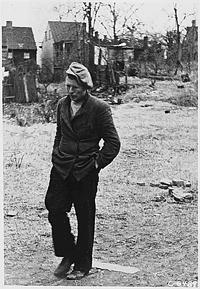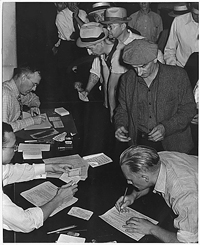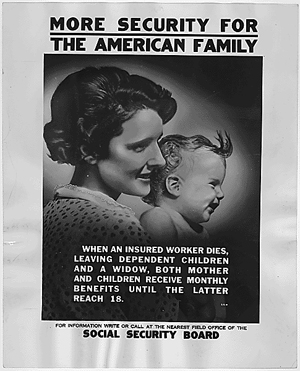To understand why the Social Security retirement program faces a $5 trillion financial shortfall over much of the 21st Century, we need to look back at some of the darkest years of the 20th.
 |
An unemployed man, 1935, in a shantytown. Social Security also established nationwide jobless insurance. |
The Great Depression swept across America in the early 1930s, leaving more than one-quarter of the work force unemployed. In some states joblessness exceeded one-third. Millions of destitute Americans fell back on a patchwork system of state, local and private relief.
Pensions were very rare until after World War I. Most people worked nearly until the time they died, or they were supported by their children or by private savings. Many lost their savings, however, in the wave of bank failures that accompanied the early years of the Depression. At the same time grown children were hard-pressed to support their own families, let alone elderly parents.
The first state-run public pension system was established in 1923. Within a dozen years pension plans were enacted by 33 of the 48 states, plus the Alaska and Hawaii territories. Most plans required residence periods ranging from five to 30 years within the sponsoring state; some were run jointly with counties or cities that could also impose residence requirements. Age requirements varied from 65 to 70 years. By the end of 1934 the Bureau of Labor Statistics reported 231,000 old-age pensioners in the state systems, double the number of just a year earlier, but still dwarfed by the 1 million recipients of emergency relief who were over age 65. Most plans limited monthly benefits to $30 or less; only New York and Massachusetts had no limit.
 |
| Unemployed workers register for jobs and file benefit claims. |
Montana established the first state-run public pension system, in 1923. (A 1912 effort in Arizona was struck down in court.) Within a dozen years, 33 of the 48 states, plus the Alaska and Hawaii territories, enacted pension plans. Most plans required residence periods ranging from five to 30 years within the sponsoring state; some were run jointly with counties or cities that could also impose residence requirements. Age requirements varied from 65 to 70 years. By the end of 1934, the Bureau of Labor Statistics counted 231,000 old-age pensioners in the state systems, double the number of just a year earlier, but still dwarfed by the 1 million recipients of emergency relief who were over age 65. Most plans limited monthly benefits to $30 or less.
Some states were unable to meet their pension burdens as the Depression cut into their tax revenues. Three of the states with pension systems made no payments at all in 1934; seven others made payments only in certain counties.
 |
Franklin Delano Roosevelt became president in March 1933. His first steps to confront the Depression were to stabilize the banking system, devalue the dollar by 75 percent - and, in the process, require all Americans to turn over their privately held gold in exchange for paper money - and get Americans back to work by providing price supports to farmers and government jobs for some wage earners. A National Recovery Administration established “codes of fair competition” to manage prices, wages, work hours and child labor in various industries to encourage private hiring.
In a June 1934 message to Congress, FDR first proposed a social insurance system to protect against “the hazards and vicissitudes of life.”
“Fear and worry based on unknown danger contribute to social unrest and economic demoralization,” he said. “If, as our Constitution tells us, our Federal Government was established among other things, ‘to promote the general welfare,’ it is our plain duty to provide for that security upon which welfare depends... Hence, I am looking for a sound means which I can recommend to provide at once security against several of the great disturbing factors in life - especially those which relate to unemployment and old age...
“I believe that the funds necessary to provide this insurance should be raised by contribution rather than by an increase in general taxation. Above all, I am convinced that social insurance should be national in scope, although the several States should meet at least a large portion of the cost of management, leaving to the Federal Government the responsibility of investing, maintaining and safeguarding the funds constituting the necessary insurance reserves. I have commenced to make, with the greatest of care, the necessary actuarial and other studies for the formulation of plans for the consideration of the 74th Congress [which was to convene in 1935].”
Roosevelt established a Committee on Economic Security chaired by Secretary of Labor Frances Perkins (the first woman to sit in the Cabinet), which convened an advisory council of experts to draft legislation that was forwarded to Congress in January 1935. The key elements of that package - enacted later that year, with some modification, as the Social Security Act -were a federal and state unemployment compensation system, an immediate federal cost sharing of state retirement systems, and a new federal retirement system.
Under the federal system, most wage earners and their employers would begin paying taxes in 1937 to build up reserves, while benefit payments would commence in January 1942. The taxes were to rise from 1 percent each on employers and employees in 1937 through 1939, to 3 percent each by 1949 and later. The first $3,000 of each employee’s wages would be covered, and benefits would range from a minimum of $10 to a maximum of $85 per month. The benefit formula skewed benefits in favor of lower-paid workers.
“In the important field of security for our old people, it seems necessary to adopt three principles,” FDR said in his message transmitting the draft legislation. “First, non-contributory old-age pensions for those who are now too old to build up their own insurance. It is, of course, clear that for perhaps thirty years to come funds will have to be provided by the States and the Federal Government to meet these pensions. Second, compulsory contributory annuities which in time will establish a self-supporting system for those now young and for future generations. Third, voluntary contributory annuities by which individual initiative can increase the annual amounts received in old age. It is proposed that the Federal Government assume one-half of the cost of the old-age pension plan, which ought ultimately to be supplanted by self-supporting annuity plans.” [The “voluntary annuities,” which sound strikingly like some of today’s proposals for “add-on” individual accounts, died in Congress, partly as a result of insurance industry objections that the government would be competing with the sale of private annuities.]
FDR’s legislation set a retirement age of 65, except that states were allowed to retain ages up to 70 in their own plans through 1939.
The Senate Finance Committee was deeply concerned about maintaining individual responsibility for paying for old-age benefits. “There is already a wide-spread demand in this country for free pensions to all old people, regardless of their needs, and also sentiment for payment of all pension costs by the Federal Government, without any requirement for State matching,” the Committee said in its report on the legislation. “There is serious danger that if only [federal cost-sharing] is enacted, this country will, before long, adopt the principle of free pensions for all old people, to be paid for from general taxes. Such a system would involve costs far exceeding any of the figures mentioned, and would bring with it evils of the most serious character, with much greater burdens upon industry than anything that is proposed in this bill.”
The committee was prophetic. Just four years later, at FDR’s urging, Congress agreed to accelerate the start of retirement annuity payments to January 1940 - and, at the same time, it deferred the first scheduled increase in payroll taxes, which did not ultimately take effect until 1950. Social Security thus went from being a user-funded retirement plan to a pay-as-you-go entitlement plan, in which benefits were not in any significant way tied to a user’s contributions.
This pattern was maintained with each subsequent major change to the system. In the 1950s a disability benefit was added. Congress enacted the Medicare adjunct in the 1960s. In the 1970s, retiree benefits were indexed to future changes in the wage levels of current workers. Just two years ago, the Bush administration supported enactment of a Medicare prescription drug benefit to take effect in 2006. Not one of these changes was ever funded by contributions of the people who collected these benefits. All have been paid for by succeeding generations.
The combined Social Security retirement and disability tax rate now stands at 12.4 percent, divided between employers and employees, on the first $90,000 of income. Medicare adds another 2.9 percent, with no income ceiling.
FDR went on to become the only president ever elected to a third term - in 1940, the year Americans began receiving those accelerated retirement annuity checks. Social Security went on to become known for decades as the “third rail” of American politics: Touching it would be political suicide.









